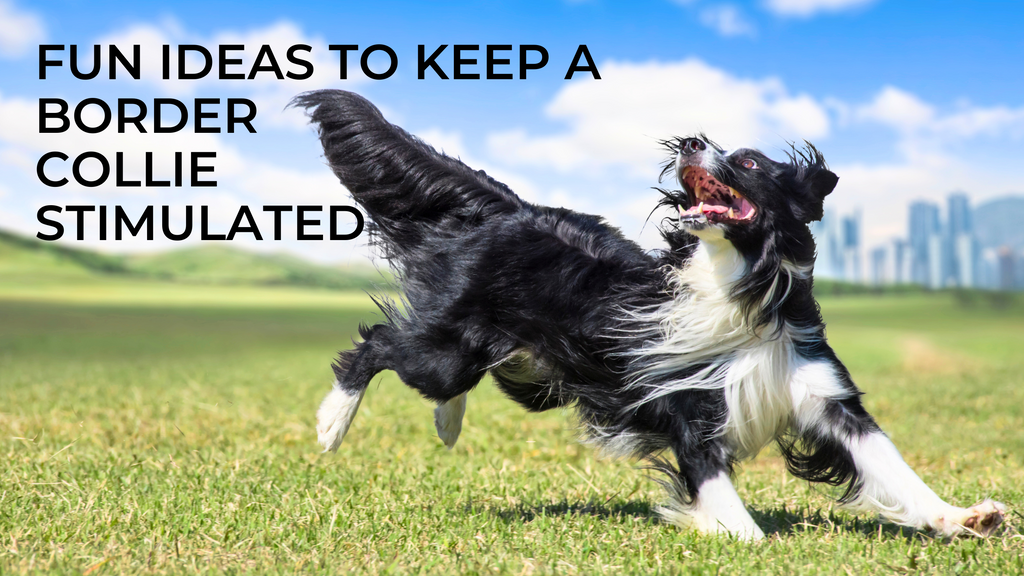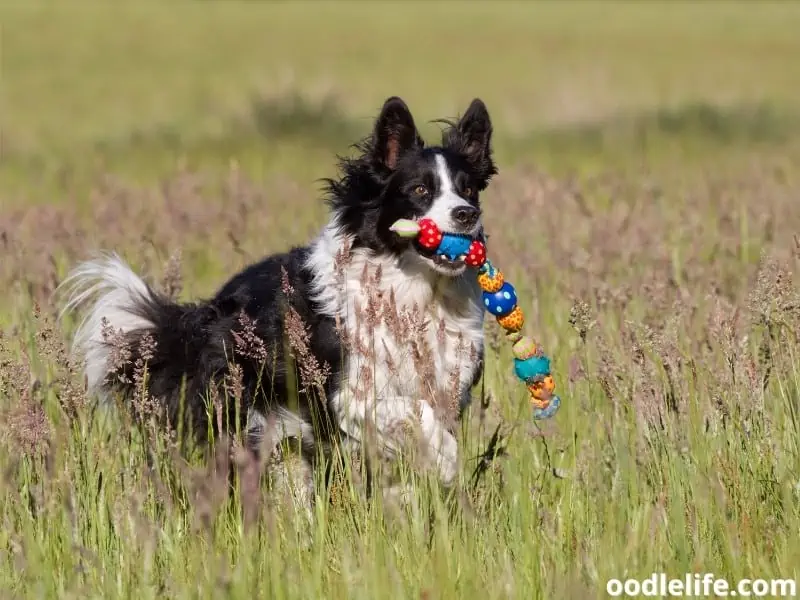How to keep a Border Collie busy at home is a question many owners grapple with. These intelligent and energetic dogs need significant mental and physical stimulation to thrive. Failing to provide this can lead to boredom, destructive behaviors, and even anxiety. This guide offers a comprehensive approach, exploring engaging games, enriching exercises, effective training techniques, and the creation of a stimulating home environment tailored to your Border Collie’s unique needs. We’ll cover everything from puzzle games to indoor agility courses, ensuring your canine companion remains happy, healthy, and fulfilled within the confines of your home.
Mental Stimulation Games

Border Collies, renowned for their intelligence and herding instincts, require significant mental stimulation to thrive. A bored Border Collie can quickly become destructive or anxious. Providing engaging mental exercises is crucial for their well-being and prevents behavioral issues. These games should challenge their problem-solving abilities and tap into their natural herding instincts, keeping them both physically and mentally occupied.
Three Challenging Puzzle Games for Border Collies
Engaging puzzle games offer a fantastic way to stimulate a Border Collie’s mind. These games require problem-solving skills, rewarding persistence and cleverness. The level of difficulty should be adjusted based on the dog’s age and experience, gradually increasing the challenge as their skills improve.
- The Treat-Dispensing Ball: This classic puzzle utilizes a hollow ball with small openings. Materials needed include a sturdy, hollow ball (tennis ball size or larger, with multiple small openings), and your dog’s favorite treats. Step 1: Place several treats inside the ball. Step 2: Roll the ball around for the dog. Step 3: The dog will learn to roll and manipulate the ball to dispense the treats. Increasing difficulty can involve using a more challenging ball design with smaller openings or a more complex surface.
- The Snuffle Mat: This puzzle engages a Border Collie’s natural foraging instincts. Materials needed include an old fleece blanket or towel, and scissors. Step 1: Cut strips of fabric from the blanket, approximately 1-2 inches wide. Step 2: Tie the strips together in knots to create a dense, textured mat. Step 3: Hide treats throughout the mat’s knotted fabric. The dog will use its nose to “snuffle” out the hidden rewards. Difficulty can be adjusted by varying the size of the knots or hiding treats more deeply.
- The Cardboard Box Maze: This game utilizes readily available materials to create a challenging obstacle course. Materials needed include several sturdy cardboard boxes (of varying sizes), treats, and tape. Step 1: Arrange the boxes to create a maze-like structure. Step 2: Place treats strategically throughout the maze. Step 3: Guide the dog through the maze initially, gradually allowing them to navigate independently. The complexity can be increased by adding more boxes, altering the maze’s layout, or incorporating tunnels.
Benefits of Food Puzzles for Problem-Solving Skills
Food puzzles are an excellent tool for enhancing a Border Collie’s problem-solving skills. The act of figuring out how to access the reward stimulates their cognitive function, improving focus and concentration. The positive reinforcement of receiving a treat upon successful completion further encourages engagement and builds confidence. Regular use of food puzzles can lead to improved mental agility and a more content, less anxious dog. For example, a Border Collie that consistently uses food puzzles may show improved ability to learn new tricks or commands compared to a dog that receives treats without engaging in problem-solving activities.
Hide-and-Seek versus Scent Work for Mental Enrichment
Hide-and-seek and scent work both offer significant mental enrichment for Border Collies, but they engage different skills. Hide-and-seek focuses on visual search and problem-solving, while scent work emphasizes olfactory skills and concentration. Hide-and-seek is relatively easy to implement at home, requiring only a person and a treat. Scent work, however, may require specialized training and tools, such as scent articles and a designated training area. Both activities provide mental stimulation and can reduce boredom and anxiety, but scent work may be more engaging for dogs with a particularly strong sense of smell.
Comparison of Mental Stimulation Games
| Game Type | Materials Needed | Difficulty Level | Estimated Playtime |
|---|---|---|---|
| Treat-Dispensing Ball | Hollow ball, treats | Beginner-Intermediate | 10-20 minutes |
| Snuffle Mat | Fleece blanket, scissors | Beginner-Advanced | 15-30 minutes |
| Cardboard Box Maze | Cardboard boxes, treats, tape | Intermediate-Advanced | 20-45 minutes |
| Hide-and-Seek | Treats, hiding places | Beginner | 5-15 minutes |
| Scent Work (basic) | Treats, scented items | Beginner-Intermediate | 15-30 minutes |
Physical Exercise at Home: How To Keep A Border Collie Busy At Home

Maintaining a Border Collie’s physical fitness indoors requires creativity and a structured approach. Their high energy levels necessitate regular exercise to prevent boredom, destructive behaviors, and potential health problems. A well-planned indoor workout routine, incorporating agility and engaging fetch variations, can effectively address their physical needs while keeping them mentally stimulated.
Indoor Agility Workout Routine
This routine focuses on exercises that can be easily adapted to a home environment, using readily available household items. Remember to always supervise your dog and adjust the intensity based on their age, fitness level, and any pre-existing health conditions. Start with shorter sessions and gradually increase the duration as your dog’s fitness improves.
A sample 15-minute routine could include:
- Weaving through legs: Have your dog weave in and out of your legs as you slowly walk across the room (5 repetitions).
- Tunnel Crawl: Use a blanket or a long piece of fabric draped over furniture to create a tunnel for your dog to crawl through (3 repetitions).
- Jump over obstacles: Use pillows, cushions, or low stacks of books as low jumps (5 repetitions per obstacle, using 2-3 different obstacles).
- Balancing on a narrow surface: A sturdy, narrow board or a straight line of taped floor can be used for balance exercises (3 repetitions).
- Tire runs: If you have a large tire (appropriately sized and secured), your dog can run around it. (3 repetitions)
Remember to reward your dog with praise and treats throughout the exercise session. This positive reinforcement helps maintain their motivation and makes the exercise a fun experience.
Indoor Fetch Variations
Fetch is a fantastic way to burn energy indoors. Modifying the game for different skill levels ensures it remains challenging and engaging.
- Basic Fetch: Throw a soft toy a short distance. Suitable for puppies and dogs new to fetch.
- Distance Fetch: Increase the distance of the throw gradually as your dog’s skill improves. This builds endurance.
- Height Fetch: Throw the toy upwards or onto a higher surface, encouraging your dog to jump and catch. This improves vertical agility.
- Target Fetch: Designate specific targets (e.g., boxes, chairs) and direct your dog to retrieve the toy from those locations. This enhances focus and obedience.
- Retrieval from a pile: Hide the toy among other objects, challenging your dog to locate and retrieve it. This improves their problem-solving skills.
Rest Periods in Indoor Exercise
Incorporating rest periods is crucial. Border Collies, despite their stamina, need breaks to avoid overexertion and potential injury. Short rest periods (1-2 minutes) should be included after every 5-7 minutes of intense activity. Observe your dog for signs of fatigue, such as panting heavily, slowing down, or losing interest, and adjust the rest periods accordingly. Provide fresh water throughout the session.
Suitable Indoor Toys for Fetch and Tug-of-War
Selecting appropriate toys is essential for a safe and enjoyable exercise session.
- Soft toys: These are ideal for gentle fetch and are less likely to cause damage to your furniture. Choose durable, well-made toys.
- Rope toys: Excellent for tug-of-war, providing a good grip and satisfying chewing experience. Opt for thick, strong ropes to prevent them from fraying quickly.
- Durable balls: Choose balls made of tough rubber or similar material to withstand enthusiastic play. Avoid balls that are too small, which could be a choking hazard.
- Interactive puzzle toys: These combine physical activity with mental stimulation, providing a more complete workout. Look for toys that dispense treats as your dog plays.
- Flirt poles: These consist of a long pole with a lure attached. They are great for building speed and agility and provide an engaging, interactive experience.
Training and Obedience Activities
Border Collies, renowned for their intelligence and trainability, thrive on mental stimulation. Incorporating training and obedience activities into their daily routine is crucial for preventing boredom and channeling their energy constructively. This section details methods for teaching new tricks, utilizing indoor obstacle courses, and promoting calmness.
Teaching a New Trick Using Positive Reinforcement
Positive reinforcement training focuses on rewarding desired behaviors, making learning enjoyable for both you and your dog. A step-by-step plan for teaching a new trick, such as “shake,” involves breaking down the behavior into smaller, manageable steps.
- Lure and Reward: Start by holding a treat near your dog’s paw. As they lift their paw towards the treat, say “shake” and immediately reward them with the treat and praise.
- Shape the Behavior: Gradually decrease the amount of lure needed. Reward any attempt to lift their paw, even if it’s not perfect. The goal is to associate the word “shake” with the action.
- Add a Hand Signal: Once your dog reliably lifts their paw on cue, introduce a hand signal (e.g., an open palm facing upwards). Pair the hand signal with the verbal cue “shake” and reward consistently.
- Fade the Lure: Gradually eliminate the lure, relying solely on the verbal and hand signals. Continue to reward consistently.
- Practice and Generalization: Practice the trick in different locations and with varying distractions to ensure your dog understands the command in various contexts.
Using Indoor Obstacle Courses to Improve Obedience and Focus, How to keep a border collie busy at home
Indoor obstacle courses provide a fun and engaging way to enhance obedience and focus. Simple courses can be created using household items such as pillows, chairs, blankets, and tunnels (easily constructed from large cardboard boxes).
A well-designed course should incorporate various challenges, including weave poles (using rolled-up towels or blankets), tunnels, jumps (using cushions or low furniture), and scent work (hiding treats for your dog to find). The course should gradually increase in difficulty as your dog progresses. Always maintain positive reinforcement throughout the training session. Reward your dog for successfully navigating each obstacle, focusing on maintaining focus and listening to your commands.
Teaching a Border Collie to Stay Calm and Relaxed Indoors
A calm and relaxed Border Collie indoors is a happy Border Collie. Several methods can help achieve this. These include:
- Structured Routine: Establishing a consistent daily routine helps your dog anticipate activities and feel secure. This includes regular feeding times, exercise periods, and training sessions.
- Designated Relaxation Zones: Create a quiet, comfortable space for your dog to retreat to when they need a break. This could be a dog bed, crate, or a quiet corner.
- Mental Stimulation Activities: Provide puzzle toys and other engaging activities to occupy your dog’s mind. This can prevent boredom and reduce anxiety.
- Controlled Exposure to Stimuli: Gradually desensitize your dog to common triggers such as loud noises or unfamiliar people. Start with minimal exposure and gradually increase it as your dog remains calm.
- Calm Handling: Approach your dog calmly and avoid sudden movements or loud noises. Gentle handling and a soothing voice can help your dog feel secure and relaxed.
Command and Hand Signal Table
| Command | Hand Signal |
|---|---|
| Sit | Open palm facing downwards |
| Stay | Raised hand, palm facing dog |
| Down | Hand moving down towards the ground |
| Come | Beckoning motion with hand |
| Shake | Open palm facing upwards |
Interactive Toys and Activities
Keeping a Border Collie mentally stimulated requires engaging toys and activities that challenge their intelligence and problem-solving skills. These interactive elements are crucial for preventing boredom, reducing anxiety, and channeling their natural herding instincts in a constructive way. A well-chosen selection of interactive toys can significantly contribute to a happy and well-adjusted Border Collie.
Homemade Interactive Toys for Border Collies
Creating homemade interactive toys is a cost-effective way to provide your Border Collie with unique challenges. These toys can be tailored to their specific preferences and skill levels, fostering a deeper bond between you and your pet. Here are three examples:
- The Treat-Filled Kong: A Kong toy, filled with frozen peanut butter, kibble, or small pieces of dog-friendly fruits and vegetables, provides a challenging and rewarding experience. The dog must work to extract the treats, stimulating their problem-solving abilities. The frozen consistency extends the playtime significantly.
- The Scavenger Hunt: Hide treats or small toys around the house or yard, encouraging your Border Collie to use their keen sense of smell and problem-solving skills to locate them. Vary the difficulty by adjusting the hiding spots and the number of items hidden.
- The Puzzle Feeder: Construct a simple puzzle feeder using cardboard boxes, plastic containers, or even empty toilet paper rolls. Create openings that require your dog to manipulate the container to access the hidden treats. The complexity can be adjusted by altering the size and shape of the openings.
Benefits of Treat Dispensing Toys for Boredom and Anxiety Management
Treat dispensing toys offer several advantages in managing boredom and anxiety in Border Collies. The act of working for a reward provides mental stimulation, diverting their attention from anxious behaviors. The predictable reward system can also be calming. Furthermore, these toys provide a sense of accomplishment, boosting their self-esteem and reducing feelings of frustration often associated with boredom. The extended playtime provided by these toys also helps to tire them both mentally and physically, leading to a more relaxed and content dog.
Effectiveness of Different Chew Toys for Border Collies
Border Collies, like many breeds, have a strong chewing instinct. Choosing the right chew toy is crucial for satisfying this need and preventing destructive chewing behaviors. The effectiveness of a chew toy depends on its durability, material, and the dog’s chewing style.
- Durable Nylabones: These are known for their longevity and ability to withstand even aggressive chewers. They come in various sizes and shapes, catering to different chewing preferences.
- Rope Toys: These provide a satisfying chewing experience and can also be used for interactive games like tug-of-war. However, ensure the rope is made of durable material and is regularly inspected for wear and tear.
- Soft Plush Toys: While less durable, soft toys can provide comfort and are suitable for gentler chewers. However, these should be supervised to prevent accidental ingestion of small parts.
Categorization of Toys by Function
Organizing toys by their function helps in providing a well-rounded approach to keeping your Border Collie entertained and stimulated.
- Puzzle Toys: Kongs, treat balls, puzzle feeders – designed to challenge problem-solving skills.
- Fetch Toys: Balls, frisbees, flying discs – encourage physical activity and coordination.
- Chew Toys: Nylabones, rope toys, plush toys – satisfy the chewing instinct and reduce destructive chewing.
- Interactive Toys: Toys that require interaction with the owner, such as tug-of-war ropes or hide-and-seek games with treats.
Creating a Stimulating Home Environment

A Border Collie’s high energy levels and intelligence demand a home environment that actively caters to both their physical and mental needs. Failing to provide sufficient stimulation can lead to destructive behaviors, anxiety, and boredom. Creating a stimulating home environment is crucial for a happy and well-adjusted Border Collie. This involves thoughtful consideration of space layout, enrichment opportunities, and designated rest areas.
Home Environment Layout for Border Collies
Designing a home layout that encourages activity and mental stimulation involves strategically placing furniture and toys. Avoid overcrowding the space, which can be overwhelming. Instead, create distinct zones for different activities. For example, a designated “play zone” can include interactive toys and puzzles, while a separate area can be dedicated to training and obedience exercises. This spatial organization helps the dog understand the purpose of each area and promotes focused engagement. Open spaces are preferable to allow for running and fetching, even indoors.
Enriching the Home Environment with Household Items
Many household items can be repurposed to create stimulating activities. Empty cardboard boxes of varying sizes can become hiding places, tunnels, or even puzzle feeders. Old towels or blankets can be used for scent work games, hiding treats within their folds. Scattering dry kibble around the house encourages foraging behavior, mimicking their natural hunting instincts. Even simple activities like rearranging furniture periodically can provide novel stimulation.
Designated Rest and Relaxation Areas
While stimulation is crucial, providing designated quiet areas for rest and relaxation is equally important. A comfortable dog bed in a quiet corner, away from high-traffic areas, allows your Border Collie to retreat and de-stress. This area should be free from distractions and provide a sense of security and comfort. The availability of such a space helps prevent overstimulation and promotes healthy sleep patterns, crucial for a well-balanced dog.
Visual Representation of an Ideal Indoor Space
Imagine a spacious living area with a section dedicated to active play. This area features a variety of toys: a sturdy chew toy, a puzzle feeder filled with kibble, and a collection of soft toys for gentle play. A durable, easily cleaned floor covering is ideal for this zone. Adjacent to the play area is a training zone, marked by a simple rug or mat, where obedience exercises can be conducted. A comfortable dog bed, nestled in a quieter corner away from the main activity, provides a peaceful retreat. The bed is placed near a window, offering a view of the outside world. Finally, a small, enclosed space like a crate (used for positive reinforcement only) could serve as a safe haven where the dog can relax undisturbed. The overall environment is bright, airy, and clutter-free, encouraging movement and exploration while also offering calm spaces for rest.






